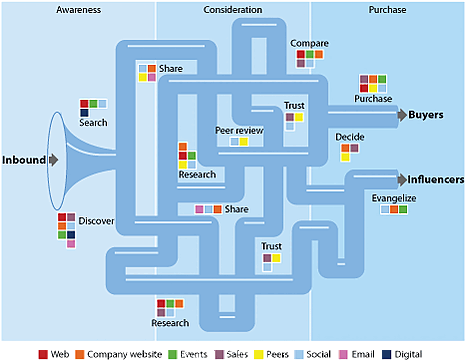CEO Blog - Advice for CEOs on growth and scaling
2 Eye-Opening Reasons that Sales and Marketing Need to Work Together - and 3 Ways to Get Started Now

.jpg?width=270&name=cutcaster-903465990-man-and-woman-shaking-their-hands-small_(1).jpg) Today, customers expect to be marketed to in the right place, at the right time, with the right message. If just one of those things is off, your content is at risk of getting deleted, or worse, being marked forever as “spam.“
Today, customers expect to be marketed to in the right place, at the right time, with the right message. If just one of those things is off, your content is at risk of getting deleted, or worse, being marked forever as “spam.“
A key to giving your audience the messaging they want to hear, when they want to hear it, is having marketing and sales teams that work together instead of independently. Sales and marketing alignment is now more important than ever because:
1. The Sales Process Has Changed
The sales process has changed, primarily because of access to information. Buyers can easily research product reviews, user ratings and social media content. Therefore, buyers control more of the buying cycle than ever before.
Sirius Decisions reports that customers perfom 67 percent of their buying process online. Similarly, a CEB study of more than 1,400 B2B customers across industries revealed that 57 percent of a typical purchase decision is made before customers even talk to a supplier.
According to Forrester Research, this is what the B2B customer’s buying process looks like now:

The bad news is, this customer journey is happening with or without your sales and marketing teams. The good news is, all of this online information is accessible to everyone in your organization. It’s time for the sales and marketing teams to work together and take control of the online conversation.
2. Organizations with tightly Aligned Sales and Marketing Processes Grow Faster
According to a 2013 study by Aberdeen Group, highly aligned sales and marketing organizations managed to achieve an average 32 percent annual revenue growth over the previous year. In comparison, their less well-aligned competitor suffered an average 7 percent decline.
Hubspot reported that organizations with good alignment between sales and marketing teams achieve 20 percent revenue growth on average annually. By contrast, companies with poor alignment saw revenues decline by 4 percent.
This data is also supported by Sirius Decisions. They found that B2B organizations with tightly aligned sales and marketing operations achieved 24 percent faster three-year revenue growth, and 27 percent faster three-year profit growth.
Through increasing the alignment between sales and marketing, each will become more effective and, in time, more successful.
Now that you’re seeing the proof of why your marketing and sales teams need to be in partnership, what are you going to do about it?
- Improve Communications
Improving communication between departments could start by something as simple as holding a weekly meeting between department managers. Or, if your sales and marketing sit in separate areas, you may want to collocate them.
Set measurable goals and guidelines for how your teams should be communicating with each other, and stick to them. For example, hold formal weekly meetings and periodic informal out-of-office meetings. In formal meetings you can review goals, results from sales calls and marketing campaigns, next steps and deliverables. In informal meetings you can work on team building and create open dialogues between the teams.
The variation of meetings and consistency of a weekly format will allow your teams to get to know each other and develop greater trust. Human relationships matter in business, and your teams won’t reach their potential without establishing trust and a thorough understanding of each other’s perspectives and challenges.
- Improve Transparency Between Sales and Marketing
Since the buying process has fundamentally changed you need to make sure that the way in which your leads are being managed parallels your customers’ journey. This way you will be in position to capture leads when they’re warm and ready to buy.
Clearly delineate the roles and responsibilities in your lead management process and create a lead scoring system which defines marketing qualified leads (MQLs) and sales qualified leads (SQLs). Most importantly, make sure that these definitions are in alignment. If there are discrepancies on what each team considers a qualified lead, work to come to an agreement and do so as soon as possible.
Another way to improve transparency between sales and marketing is to make sure that your marketing team provides analytics to the sales team on campaigns. In turn, ask the sales team to report on conversions from qualified leads. As your lead management process matures, you may want to consider implementing tools such as:
- Customer relationship management (CRM) software to manage, track and store lead sources
- Marketing automation to create, implement, manage, monitor and measure marketing campaigns.
(Read more about CRM and Marketing Automation Role in Day-to-Day Business)
3. Build Mutual Respect
Another way to create alignment between sales and marketing is to build respect for the different skills each team uses in performing their jobs.
Your marketing team can better understand a day in the life of a salesperson by shadowing sales calls. Marketing can then observe common objections your sales team encounters, and subsequently provide more effective tools for the sales team to utilize to educate the customer and move them through the buying process.
And on the other hand, your sales team can sit in on marketing strategy discussions and creative development sessions. Participating in these meetings will allow them to more clearly understand the marketing strategy ideation process and help create more powerful calls to action. They will also gain an appreciation for the time and effort it takes to hone the marketing message.
Fostering a team environment between your sales and marketing teams takes time, but it is worth the investment. By better aligning sales and marketing, your company is more prepared to deal with the fundamental change in the buying process that information access has created and your company is also set up for faster growth.
Topics: Alignment, Sales and Marketing Integration
Thu, Oct 23, 2014Featured Chief Outsider
/CMO-Beth-Somplatsky-Martori.jpg?width=200&height=200&name=CMO-Beth-Somplatsky-Martori.jpg)
Beth Somplatsky-Martori
Related Articles

- Press Releases
- Careers
- Case Studies
- Marketing Consultant Company
- Marketing Strategy Consultants
- Marketing Plan Consultants
- B2B Marketing Consultants
- Virtual CMO
- Marketing Consultant Outsourcing
- Fractional CMO
- What is a Fractional CMO
- Healthcare Marketing Consultant
- Marketing Consultant Houston TX Texas
- Marketing Consultant Texas TX
- Marketing Consultant Bay Area
- CEO Blog
- Ebooks Plus
- Executive Marketing Consultants
- Product Marketing Consultants
- B2C Marketing Consultants
- Virtual Marketing Consultants
- Senior Marketing Consultants
- Temporary CMO
- Hire a CMO
- Fractional CMO Salary
- Fractional CMO Responsibilities
- Marketing Consultant Austin TX Texas
- Marketing Consultant Dallas TX Texas
- Marketing Consultant San Antonio
- Helping Private Equity
- Private Equity Blog
- Leadership Team
- Privacy Policy
- Business Marketing Consultants
- Strategic Marketing Consultants
- Marketing Technology Consultants
- Sales and Marketing Consultants
- CMO Job Description
- CMO Salary
- Fractional CMO Agency
- Fractional CMO Services
- CPG Marketing Consultant
- Marketing Consultant San Diego
- Partners
Houston, TX 77056
© 2023 Chief Outsiders

